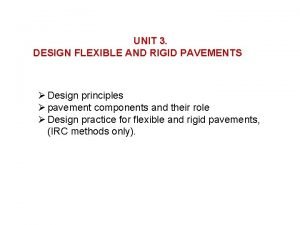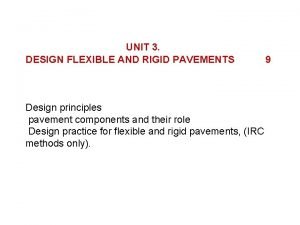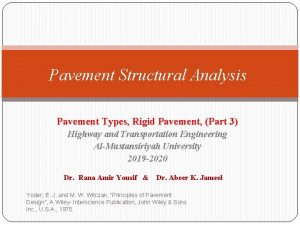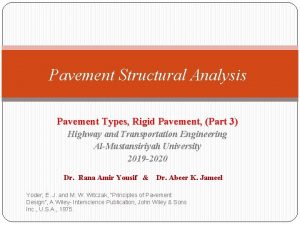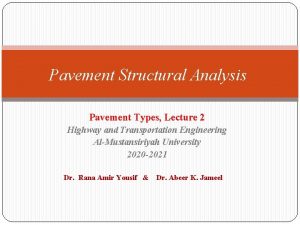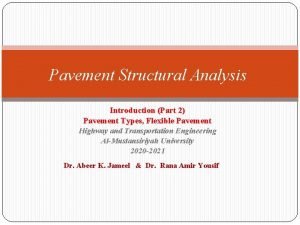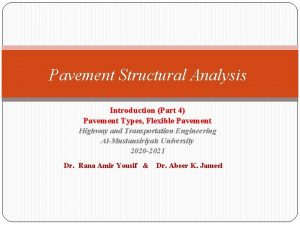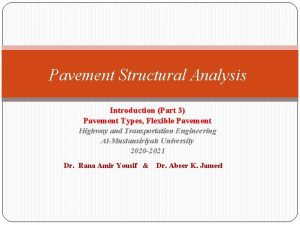Pavement Structural Analysis 3 rd Stage Lecture 2









- Slides: 9

Pavement Structural Analysis 3 rd Stage Lecture 2 Lecture. Rana Amir Yousif Highway and Transportation Engineering Al-Mustansiriyah University 2018 -2019

References: � Nicholas J. Garber and Lester A. Hoel. ”Traffic and Highway Engineering”, Fourth Edition. � Yoder; E. J. and M. W. Witczak, “Principles of Pavement Design”, A Wiley- Interscience Publication, John Wiley & Sons Inc. , U. S. A. , 1975. � Yaug H. Huang, “Pavement Analysis and Design”, Prentic Hall Inc. , U. S. A. , 1993. � “AASHTO Guide for Design of Pavement Structures 1993”, AASHTO, American Association of State Highway and Transportation Officials, U. S. A. , 1993. � Oglesby Clarkson H. , “Highway Engineering”, John Wiley & Sons Inc. , U. S. A. , 1975.

Typical layers of a flexible pavement Typical layers of a conventional flexible pavement includes seal coat, surface course, tack coat, binder course, prime coat, base course, sub-base course, compacted sub-grade, and natural sub-grade Seal Coat: Seal coat is a thin surface treatment used to water-proof the surface and to provide skid resistance. Tack Coat: Tack coat is a very light application of asphalt, usually asphalt emulsion diluted with water. It provides proper bonding between two layer of binder course and must be thin, uniformly cover the entire surface, and set very fast. Prime Coat: Prime coat is an application of low viscous cutback bitumen to an absorbent surface like granular bases on which binder layer is placed. It provides bonding between two layers. Unlike tack coat, prime coat penetrates into the layer below, plugs the voids, and forms a water tight surface. Surface course: is the layer directly in contact with traffic loads and generally contains superior quality materials.

They are usually constructed with dense graded asphalt concrete (AC). The functions and requirements of this layer are: � It provides characteristics such as friction, smoothness, drainage, etc. Also it will prevent the entrance of excessive quantities of surface water into the underlying base, sub-base and sub-grade, � It must be tough to resist the distortion under traffic and provide a smooth and skid- resistant riding surface, � It must be water proof to protect the entire base and sub-grade from the weakening effect of water.

Binder course This layer provides the bulk of the asphalt concrete structure. Its chief purpose is to distribute load to the base course the binder course generally consists of aggregates having less asphalt and doesn't require quality as high as the surface course, so replacing a part of the surface course by the binder course results in more economical design. Base course The base course is the layer of material immediately beneath the surface of binder course and it provides additional load distribution and contributes to the sub-surface drainage It may be composed of crushed stone, crushed slag, and other untreated or stabilized materials.

Sub-Base course The sub-base course is the layer of material beneath the base course and the primary functions are to provide structural support, improve drainage, and reduce the intrusion of fines from the sub-grade in the pavement structure If the base course is open graded, then the sub-base course with more fines can serve as a filler between sub-grade and the base course A sub-base course is not always needed or used. For example, a pavement constructed over a high quality, stiff sub-grade may not need the additional features offered by a subbase course. In such situations, sub-base course may not be provided.

Sub-grade The top soil or sub-grade is a layer of natural soil prepared to receive the stresses from the layers above. It is essential that at no time soil sub-grade is overstressed. It should be compacted to the desirable density, near the optimum moisture content.

Failure of flexible pavements The major flexible pavement failures are fatigue cracking, rutting, and thermal cracking. The fatigue cracking of flexible pavement is due to horizontal tensile strain at the bottom of the asphaltic concrete. The failure criterion relates allowable number of loadrepetitions to tensile strain and this relation can be determined in the laboratory fatigue test on asphaltic concrete specimens. Rutting occurs only on flexible pavements as indicated by permanent deformation or rut depth along wheel load path. Two design methods have been used to control rutting: one to limit the vertical compressive strain on the top of subgrade and other to limit rutting to a tolerable amount (12 mm normally). Thermal cracking includes both lowtemperature cracking and thermal fatigue cracking.

1. 2 Rigid Pavements: A rigid pavement is constructed from cement concrete or reinforced concrete slabs. Grouted concrete roads are in the category of semi-rigid pavements. Figure 1. 4 shows a typical cross section for rigid pavements. In contrast to flexible pavements, rigid pavements are placed either directly on the prepared subgrade or on a single layer of granular or stabilized material. Because there is only one layer of material under the concrete and above the subgrade, some call it a base course, others a subbase. Figure 1. 4: Typical cross section of a rigid pavement (1 in. = 25. 4 mm).
 Flexible pavement
Flexible pavement Flexible and rigid pavement
Flexible and rigid pavement Difference between flexible pavement and rigid pavement
Difference between flexible pavement and rigid pavement Pavement structural design
Pavement structural design 01:640:244 lecture notes - lecture 15: plat, idah, farad
01:640:244 lecture notes - lecture 15: plat, idah, farad Stage 2 denial
Stage 2 denial Difference between upstage and downstage
Difference between upstage and downstage Proscenium stage directions
Proscenium stage directions What is two stage tendering
What is two stage tendering Downstage and upstage
Downstage and upstage
